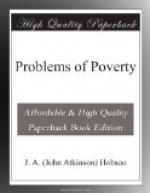Chapter VIII.
The Industrial Condition of Women-Workers.
Sec. 1. The Number of Women engaged in Industrial Work.—The evils of “sweating” press more heavily on women workers than on men. It is not merely that women as “the weaker sex” suffer more under the same burden, but that their industrial burden is absolutely heavier than that of men. The causes and the meaning of this demand a special treatment.
The census returns for 1901 showed that out of 4,171,751 females engaged in occupations about 401/2 per cent. were in domestic or other service, 381/2 per cent. in manufactures, 7 per cent. in commerce, chiefly as shop-assistants, 4 per cent. in teaching, 3 per cent. in hotels, boarding-houses, etc., and 7 per cent. in other occupations.
The following table gives the groups of occupations in which more females are employed than males:—
Occupational Groups
Males Females
Sick nurses, midwives, etc.
1,092 67,269
Teaching
61,897 172,873
Domestic service
124,263 1,690,686
Bookbinding: paper and stationery manufactures
42,644 64,210
Textile manufactures
492,175 663,222
Dress manufactures
336,186 689,956
--------------------
1,058,257
3,348,216
All other occupations 9,098,717
823,535
--------------------
All occupations 10,156,974
4,171,751
The manufactures in which women have been gaining upon men are the textile and clothing trades in almost all branches, tobacco, printing, stationery, brushes, india-rubber, and foods.
Sec. 2. Women’s Wages.—Turning now to women engaged in city industries, let us gauge their industrial condition by the tests of wages, hours of labour, sanitary conditions, regularity of employment




